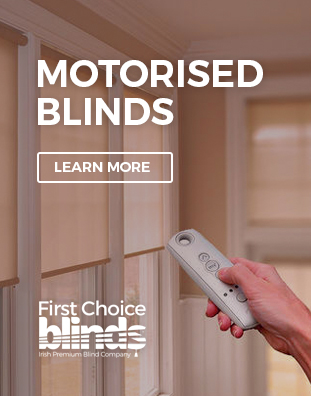Uncategorized
Best Blinds In Dublin
First Choice Window Blinds
Discover the perfect window blinds for your home! With thousands of styles and colors to choose from,
our experts will help you choose the ideal blinds for your windows.
We provide quality blinds at competitive prices and
our experienced staff is here to help you find the perfect style and fit for your home.
At First Choice Blinds we will have a shading solution for you.
Our expert service includes free appointment and free fitting
First Choice Blinds has been Dublin’s leading family-run blinds business since 2000 offering an extensive range of window blinds,
from Roller Blinds, Wood Venetian Blinds, and Pleated Blinds to Shutters, Motorised Blinds, and lots more!
We cover Dublin and surrounding areas.
If you’re looking to spruce up your home, various window treatments do this well. Whichever you decide to choose, it is already an improvement that is not only therapeutic but usually raises its resale value. We can confidently say that one of the trends that are truly catching on is different types of blinds.
Blinds are marvellous and versatile window dressings that have captivated so many people. You can now find them in an ever-increasing number of homes and offices as they have become a favourite with homeowners as well as interior designers. Different types of blinds cater to different tastes and needs giving you a wide range of choices.
They come in various styles, colours, materials and textures, appealing to every décor theme in the home or office. Blinds cover all types of windows, from extra large conservatory windows, skylight windows, arch windows to bi-folds and everything in between. With the bespoke blind options, any blind can be a custom fit for any type of window.
Thanks to innovation, special functional features are now commonplace when it comes to blinds. These features include but are not limited to blackout materials, day and night blinds, thermal insulation, noise cancellation, among others. These features ensure you get more from your blinds and even save on power costs with the help of thermal insulating materials.
This ultimate 2023 guide will cover all the different types of blinds and list their pros and cons. We will also help you determine which blind is best for your window and in which room. But first, a look at some of the factors you need to consider before choosing blinds:
Factors to consider when choosing different types of blinds
Window type
The window type usually dictates the blinds you choose including the size. Keep in mind your windows opening mechanism. The size of the opening mechanism and the type of mount you wish to have on your blinds also matters.
Do you want an inside or outside mount? Remember, an outside mounted blind gives the appearance of a larger window, while an inside mount fits perfect with the minimalistic look. Skylights will require skylight blinds, while not all blinds will be suitable for arched windows.
Style
Whether you are a DIY person or your home has been professionally done by an interior designer, you want the blinds you choose to complement your style. From the blinds materials, colours, textures and patterns. There is a lot that you will need to consider. But with all the different types, this will not be difficult.
Family safety
A household with young children and pets may opt for cordless blinds as dangling cords can be prone to snapping. At First Choice Blinds, we ensure our vast array of blinds come child and pet safe. Also, various rooms require different blinds depending on the needs of the family. For instance, a media room will need total blackout blinds, while a home office will need soft lighting for a conducive working atmosphere.
Privacy and light control
The degree of privacy you wish to have will dictate the type of blind you choose. If your window faces the street and the room is at ground level, you need a blind that maintains privacy while letting in light. The best blind, in this case, will be either Venetian or vertical blinds. Other blinds have to retract for you to enjoy the view.
Needs of the room
Rooms such as kitchens and bathrooms require unique materials due to the high moisture presence. The type of blind you choose should be moisture resistant, while bedrooms may need blackout materials for a conducive sleeping environment. Also, nurseries need blinds that will ensure they are comfortable sleeping even during the day.
Budget
The amount of money you are willing to spend on the blinds will dictate the type you choose. If your budget is limitless, then so are the choices of bespoke options you can get. Sleek designs, top the range materials, finishes and textures are all available for those who are ready to spend. That’s not to say quality drops on the lower end of the divide either, budget vinyl and synthetic fabric blinds will still serve the purpose at a lower price.
These are some of the main factors that will influence your decision. To help you further make an informed choice, we will look at each blind’s features and where best to use them.
Materials you can expect from different types of blinds
Different types of blinds come in varied materials. We have wooden, faux wood, fabric, vinyl, plastic, and metal. Your budget and the room where you are installing the blinds usually dictate the material you will choose. Some rooms have special needs that require specific materials. High-quality natural materials are more expensive compared to their synthetic counterparts.
Plastic and vinyl blinds are cheaper compared to natural wood. But, natural wood will be a terrible choice for the bathroom as moisture may damage it. Plastic, vinyl and faux wood are excellent choices for the bathroom and kitchen behind sinks as they are moisture-resistant. Below is a look at each of them in detail.
Real wood
Wood has a warmth and natural appeal that you will not find anywhere else. It brings the outdoor feel to the home when installed in any room. Wood can be pricey but comes in the most beautiful finishes to complement your farmhouse look, among others.
First Choice Blinds offer varying slat are a delight and favourite of many. Mini and micro blinds may also come in wood. Wood is durable if you take good care of it. But you cannot use wood in high moisture areas as it tends to warp and get damaged.
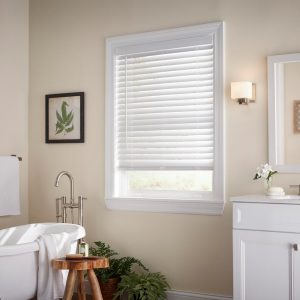
First Choice Blinds Faux wood
For the same look of natural wood but at a lower price, faux wood is the best alternative. In addition to complimenting many modern interior design themes, the synthetic wood material is moisture resistant. You can use First Choice Blinds Faux wood in the kitchen and bathroom. It comes in many beautiful colours and also wood finishes. Faux wood Venetian blinds have remained at the height of popularity for many years now, and don’t show signs of going out of style any time soon!
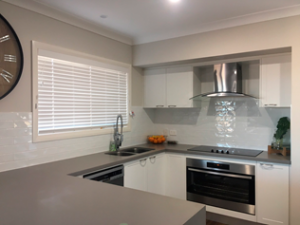
P.V.C Roller blinds
Vinyl blinds are resistant to moisture and UV light while also being a low-cost material for making blinds. You can spot vinyl blinds in offices and government buildings. Come in various colours and shapes, which makes the material suitable for many styles of blinds. It is easy to take care of vinyl blinds, and they last for a long time.
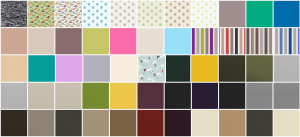
First Choice Blinds Fabric
From an interior design angle, they are more versatile in terms of texture and colours. Synthetic fabrics are usually more preferred in making blinds, and their appearance should not fool you. They offer unique properties such as UV light protection and flame redundancy. Unlike other materials, they are prone to collecting dust, and you may need to thoroughly wash them regularly if you or one of your family members suffer from allergies.
First Choice Blinds Aluminium
The metal you will find blinds in is often aluminium as it is lightweight and does not rust. Aluminium is cheap and flexible and makes Venetian blinds with a variety of slat sizes. If done well, aluminium Venetian blinds can complement several interior decor styles for the home.
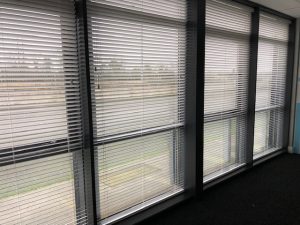
Natural materials
Eco-friendly natural materials such as bamboo and seagrass also make blinds. They don’t fare as well against exposure to rays of the sun compared with synthetic materials. In addition to discolouration, they also break down easily over time. Natural materials are always a bit more expensive, even though they make an attractive addition to the home.

Different types of blinds By First Choice Blinds
There are various styles of blinds available on the market, each with its place in the home or office. New arrivals are constantly entering the market with a few enhancements to benefit the end-user. Blinds are a long term investment and you should not pick them in a hurry.
Always make sure to take your time and when possible, consult with a professional so that you make the right choice. We will look at the different types of blinds in detail and list their pros and cons to help you make the right choice.
Vertical blinds
As the name suggests, these blinds comprise vertically oriented slats or vanes that attach to a track at the top of the window. They operate using a pulley system. When the operating chain or cord, pulling, moves the vanes from left to right, retracting to the side. This action completely opens the window.
A wand controls the angling of the vanes to any degree you wish. Angling the vanes filters the amount of light you let into the room. The vanes can be joined together by a chain at the top and bottom, but some vertical blinds allow the vanes to move freely.
These versatile blinds come in various materials. They include PVC, fabric, plastic, wood, fabric and bamboo, among others. Vertical blinds are lightweight and often find use in large and extra-large windows. The track can take the shape of a curved window recess.
Where to use vertical blinds?
First Choice Blinds Vertical blinds are a great way to address the privacy and light control needed. Adjusting the vanes throughout the day helps you light the room while still maintaining privacy.
Other large windows that immensely benefit from vertical blinds are bay windows. When you need to enjoy the view, it’s as easy as retracting the vanes to the side. But when the glare of direct light becomes too much, angling the vanes control the light.
While in the office, direct glare on the monitor will give you a headache or make it impossible to work. Vertical blinds are an excellent choice as they control the light while still allowing a measure of natural light into your office space. They also make beautiful partitions within the office to provide privacy.
Bifold and sliding doors also benefit from the use of vertical blinds. It’s easy to move them out of the way to open the door.
Pros
- Excellent privacy and light control
- Provides thermal insulation, more so if you use thicker vanes
- It’s easy to use vertical blinds and maintain them
- They are relatively cheap
- Add height to any room
Cons
- Lets rays of light in if the vanes become misaligned
- Any movement of the vanes results in noise
First Choice Blinds Roller blinds
Comprise a single piece of fabric wrapped around a free-spinning rod held inside a casing at the top of the window. Operated by a chain or cord attached to the pulley system and hangs at the side of the roller blind. Or by a pull cord at the bottom of the blind.
In contrast, double roller blinds comprise two fabric pieces operated independently but found on the same blind. Usually have opaque and sheer material in the same blind. They can alternate depending on the specific need at the time.
They come in beautiful colours, patterns and materials.The fabrics in use receive treatment to maintain rigidness. Follow instructions when cleaning your roller blinds fabric to maintain its integrity.
Where to use roller blinds?
Roller blinds find use in almost all the rooms of a home. Thanks to the different fabrics used to make them. From the bedroom to the living room, blackout fabric or translucent materials make the blind suitable for every situation. They are also perfect for skylights.
Pros
- They are cost-effective
- Double roller blinds enhance light control
- Easy to match with your interior decor as many materials are available
Cons
- They are not effective in insulation compared to some other blinds.
First Choice Blinds Venetian blinds
They may come in various materials such as natural wood, faux wood, aluminium and plastic. Though a new style of blinds is coming up now and then, Venetian blinds have stood the test of time and are still as popular as they were in the 1930s and 1950s.
They operate through a cord and tilt mechanism. Each slat has holes 5 inches from the end. A cord runs through these holes and is used to pull the blind open and close. When you open the window, the slats stack together at the top.
The tilt mechanism tilts the slats 180 degrees upwards or downwards. When the slats tilt, you achieve a varying degree of light control while maintaining privacy.
The slats come in varying sizes of 35mm and 50mm. Keep in mind bigger slats allow more light into a room. The mini and micro blinds have slats of less than an inch, micro being smaller. The two may suit the bedroom to give an almost blackout effect.
Where to use Venetian blinds?
They suit all rooms of the home thanks to the different materials. Choose faux wood or plastic Venetian blinds for the bathroom or kitchen. Decorate your home in the beautiful wood finishes or varied colours of faux wood and aluminium blinds, and you will not regret your investment as they stay in style for a long time.
Though they block most light, pinholes sometimes allow a slither of light to pass through even when closed, meaning it is unsuitable for the bedroom. Also, the slats may allow some light to pass through when the blind is closed.
Each type of Venetian blind has its advantages and disadvantages, but they all work similarly.
First Choice Blinds Wooden Venetian blinds
They come in several finishes, such as matt, gloss and satin. Though a bit on the higher side, compared to other blinds in this category. They are durable and transform your home by adding a touch of elegance and though they are not the best option, they may dress extra-large windows. Natural wood has no equal when it comes to adding sophistication and warmth to a room. Match well with many choices of interior decor.
Pros
- Offer stylish finishes
- Lightweight compared to faux wood
- Block a decent amount of light
Cons
- A bit expensive compared to other Venetian blinds
- Not suitable for use in high moisture areas
Faux wood Venetian blinds
Faux wood Venetian blinds come in a variety of colours and are cheaper compared to natural wooden blinds. They are suitable for use in the bathroom and kitchen behind the sink as they are moisture resistant. They are long-lasting and easy to maintain. For the timeless wooden look at a fraction of the cost.
Pros
- Suitable for high traffic areas
- Easy to clean
Cons
- Not suitable for use for large windows
Aluminium Venetian blinds
They are common in offices though they would do very well in the home setting. Come in a variety of colours, are waterproof and easy to clean. You can install them in the bathroom or kitchen without worry. When taken care of properly, they are very durable. It’s easy to match or complement your existing decor theme, thanks to the different colours and styles available.
Pros
- High quality and affordable
- Easy to clean
Cons
- Some people find the operating mechanism hard to operate in the beginning.
Pleated blinds
First Choice Blinds pleated or Honeycomb fabrics are the common materials manufacturers use when making roof lantern blinds. A single piece of material makes the blind. They come in pleats sizes of 20mm and 25mm sizes, but large 50mm size pleats are also available in apex fabric. The pleatings form a beautiful accordion design when folded. They add texture which is one of the most important interior design elements.
A cord mechanism operates the blinds, but you may also motorise them for more convenience. Opaque, semi-opaque and translucent fabrics are available. They come in a variety of shapes, sizes, and finishes. Pleated blinds can easily fit odd-shaped windows like arch windows.
You can opt for free-hanging pleated blinds or choose the tensioned style, which does not move when you open the window. They can be dusted using a feather duster or wiped with a dry cloth. Schedule regular vacuuming but only with the upholstery brush attachment.
Where to use pleated blinds?
Any room in the home will benefit from the added stylish, delicate, soft touch of the pleated blinds. They are perfect for the conservatory windows and roof. Dress any skylight in style by choosing from the various materials available for pleated blinds.
Pros
- They are less expensive than cellular blinds
- Available in a variety of fabrics
- Have a small stack when the blind is open
Cons
- Poor insulators which will not do during winter
- Pinholes for threading the cord are visible from both sides
- Allow dots of light to pass through the pinholes
First Choice Blinds Cellular blinds
Give the same look as pleated blinds though their construction is very different. Comprise two or more pieces of materials pleated and joined together to form long channels. From the side, they almost look like a honeycomb.
The long channels trap air providing insulation in all seasons. They save you in power cost as they help in keeping warm air inside during winter. Also, they preserve the cool air inside the house in hot summer months, lowering your air conditioning costs.
Another great feature of cellular blinds is the hidden operating cord. It is tucked away from sight by threading through the cells. Cellular blinds come in opaque or translucent fabrics. Translucent fabrics filter light but keep the heat at bay.
Also available in 20mm and 25mm pleat sizes. They can have one, two, or three cells. The higher the cells, the more expensive the blind will be. But the more insulating power it will have. It is also important to point out that they are available in the top-bottom, bottom-up style for more privacy control.
Where to use cellular blinds?
Cellular blinds are suitable for any room and window in the house.
Pros
- Excellent insulators
- Better privacy control than pleated blinds
- They offer noise cancellation thanks to the air pockets.
Cons
- Hard to clean thoroughly because the cells
- A bit pricey
- Some homeowners do not think they are stylish
Roman blinds
For those who wish for the look of curtains but want the simplicity of blinds.They give a cosy feel and add warmth to any room while maintaining an elegant continental style. Small rooms where it is difficult to fit a curtain rod are great candidates for roman blinds.
First Choice Blinds Roman blinds consist of a single piece of fabric with strings strategically sewn in it. Pull the cord, and the fabric folds on itself, forming stacked pleats at the top of the window much like Venetian blinds. Although there are some complaints that the blind takes up too much space at the window top, some homeowners love these blinds precisely for that reason.
They are available in a variety of fabrics, sizes, colours and patterns. You are sure to find the Roman blind that suits you. Some Roman blinds have heavyweight fabric, which makes them unsuitable for large windows.
Where to use Roman blinds?
For use in areas with high moisture, ensure the fabric is resistant. Regular Roman blinds are suitable for any room in the home.
Pros
- Provide excellent insulation
- Bring a luxurious feel to any room
Cons
- Depending on the choice of fabric may be expensive
- Some people find them difficult to clean
Special features of different types of blinds
Modern-day blinds have undergone innovations that have resulted in special features that make the experience of using blinds easier. Some of them enhance the safety of blinds while making them more functional.
Perfect fit blinds
The result is a neat compact window blind. Different styles of blinds such as roller, Venetian, pleated, cellular and roman blinds work with perfect fit frames. Suitable for any window type and doors such as bifold doors.
Day and night blinds
Also be known as duo roller, zebra, mirage and vision blinds. They offer the versatility of blackout and translucent functions in one blind. Simply put, they are two roller blind in one casing. The different fabrics are striped, with one being stationary and the second one movable. You can align the opaque stripes for a complete blackout.
Skylights and roof window blinds
Whether flat roof, loft, conservatory roof windows, of any type will benefit from a well-chosen skylight blind. They are available in Venetian, roller or pleated blinds. The needs of a skylight are unique, and hence its subcategory of blinds. They can either be operated by plastic poles or remote for the motorised option.
First Choice Blinds Blackout blinds
To enjoy a good nap or a well deserved night’s rest, you need a conducive environment. It is essential to keep disturbing light from your bedroom. Blackout materials are tightly knit together to block light. And they do not need to be dark coloured. You can find blackout fabric in a variety of colours to suit your needs.
They are also suitable for media rooms if you want to have a theatre experience. Any type of blind that uses fabric is a good choice for a blackout fabric.
Thermal material
While blinds offer some insulation, albeit not all of them, attaching a thermal lining fabric to the back of the blind will enhance this function. The lining traps warm air inside the house. During winter, open the blinds to allow as much warm air inside as possible and close them at night to trap the air inside the house.
Cordless blinds
Cords and chains are a strangulation hazard for young children and pets. Cordless operated blinds eliminate the use of cords in blinds operation by making use of the bottom rail. Cordless are also popular with homeowners because they are neat. They eliminate the need for hanging cords and chains.
Operation of different types of blinds
Blinds operate either manually or automatically
Manually operated
You physically operate the control mechanism to open or close the blind. In some blinds like vertical and Venetian, the control is through a rod and cord. The rod controls the tilt of the slats while the cord/chain controls the opening or closing of the blind. Cordless blinds also fall under manually operated.
Automatic
First Choice Blind operate at the touch of a button. Smart technology has made it possible to operate your blinds via your smartphone using Bluetooth.
